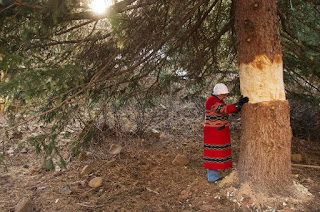by Thomas S. Bremer
Earlier this month the world received news that 832F had
been killed. As reported in the New York Times and elsewhere, a
hunter brought down the most famous and widely recognizable of the Yellowstone
wolves fifteen miles outside of the national park boundaries in Wyoming.
As someone prone to pondering the cultural significance of
Yellowstone’s history, I found myself thinking about 832F, the alpha female of
the Lamar Canyon pack, and was surprised by my ambivalence over her death. Perhaps my mixed feelings reflect a broader cultural
ambivalence modern westerners have held in their regard for not only wolves,
but wildlife in general.
832F, as the Times
reporter Nate Schweber points out in his article, had achieved the status of
“rock star” among certain wildlife aficionados.
She was, by my reckoning, a fully aestheticized commodity in a tourist
economy of wildlife, national parks, and outdoor adventure. In eco-tourist discourses on Yellowstone, the
image of the wolf has become an iconic figure representing the virtues of
biodiversity, wildness, and a benevolent humanity that brings rational science
to bear on a compassionate regard for animals. Moreover, the possibility of
wolf sightings in the highly managed landscapes of Yellowstone National Park
contributes to the authenticity of the park for tourist visitors; to see live
wolves in the wild affirms in touristic discourses that Yellowstone is indeed
an authentically wild place, and therefore a more appealing tourist
destination, itself an ironic development that belies the claim of wildness.
On the other hand, the very wildness of wolves is what
threatens another sort of economy and discourse, that of ranchers and wildlife
managers in areas surrounding the park.
Particularly for agricultural interests, the wolf represents a dangerous
predator whose attacks on livestock imperil the very foundations of western
civilization, besides harming their own personal financial interests. There are plenty of folks in Wyoming,
Montana, and Idaho, as well as throughout the western United States, who are
convinced that extermination of wolves is a good thing, in fact necessary for
the profitable success of the livestock industries.
As a historian of American religions, I wonder what sort of
critical perspective I might contribute to such debates. I am not sure a good religious history of
wolves has been written, although Barry Lopez’s impressive book Of Wolves and Men includes numerous
references to cultural traditions and folkloric legends that rely on religious orientations.
Lopez contends, “The truth is we know
little about the wolf. What we know a
good deal more about is what we imagine the wolf to be” (3). As I reflect on the human imagination of the
various subspecies of Canis lupus, it
seems to me that the critical questions for scholars of religions have to do
with how religious orientations, perspectives, assumptions, practices, and
images have contributed to and informed various wolfian discourses.
For those of us interested specifically in the western
regions of North America, one discourse with urgent political ramifications has
to do with the reintroduction of wolf populations in areas where wolves had
been earlier exterminated. Scholars of
religions could help elucidate historical and anthropological perspectives on
religious considerations underlying the cultural ambivalence toward wolves that
informs both sides of the debate. Insight into the religious aspects of
collective attitudes toward the Yellowstone wolves, I surmise, will take us
beyond wolves and far outside the park boundaries of Yellowstone, for it ultimately
concerns self-understandings of the human relationship to nature, animals, and
the places we deem as wild. Perhaps we
might even come to terms with both the sadness and the necessity of losing 832F
to the hunter’s skillfully placed shot.







.jpg)



